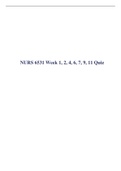Exam (elaborations)
(BLP DISTINCTION LPC) A binder of many helpful tables on the BLP workshop topics which take you through how to answer the exam!
- Institution
- University Of Law (ULaw)
I have combined all of the tables I created for this exam and they are so comprehensive that I didn't even need the textbook. These tables give you the exact information each question requires, statute and all and will guarantee you a distinction if you go through all of the steps. You can ...
[Show more]













